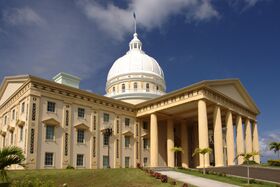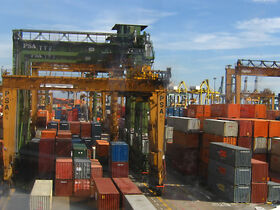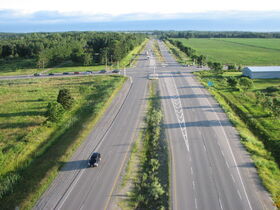| New Shetland | |||
|
| |||
| Name | New Shetland | ||
|---|---|---|---|
| Full name | United States of New Shetland and the Ascension Islands | ||
| Capital | Marbella | ||
| Official languages | English, Spanish | ||
| Demography | |||
| Population | 11 million | ||
| Demonym | Shetlandian | ||
| Government | |||
| President | Thomas Warwick | ||
| Vice president | Peter Rojas | ||
| Other information | |||
| Motto | Quae caret ora cruore nostro | ||
| Anthem | God Save the Queen | ||
| Currency | New Shetland Dollar | ||
| Internet TLD | .ns | ||
| ISO 3166-1 | NS | ||
| Telephone code | +671 | ||
| |||
New Shetland (officially United States of New Shetland and the Ascension Islands) is a country and sovereign state in the Pacific Ocean, west of the United States at approximately 35°N 159°W. New Shetland is a federation and consists of 30 states with a combined population of 11 million inhabitants. The country has been independent since 1923, preceded by a long history of colonial dependence. Nowadays, the country forms a democratically governed member of the commonwealth together with the Ascension Islands and the Harvian Islands, that respectively joined the country in 1946 and 1923. New Shetland is a member of the United Nations and the WTO, and serves as a role model for other Pacific nations, as it has one of the highest life standards of the Pacific area and a stable, thriving economy.
New Shetland is mostly an industrial nation with a big mining industry and lots of forestry. Intensive dairy farming and meat production is practised in small core areas in the southern tip of mainland New Shetland, as well as the centrally situated Nieves Valley. Important cities include Marbella, Dunbeg, Pinggo, Mount Errigal, Blakeney, Yarmouth and Ralston. Demographically spoken the country is a mixture of native inhabitants, that live mostly in the Harvian Islands and the northern part of mainland New Shetland, and European descendants of colonists that moved to the country in the 19th and 20th centuries. Most of these European colonists hail from British territories such as Wales, Scotland and England, and from central European countries such as Germany, Poland, Bohemia (now the Czech Republic) and Dalmatia (present-day Croatia). Other important groups include Spanish and Russian dissidents, Jewish WWII refugees and east-European expats. Indian and Chinese workers make up a significant part of the population of Marbella. There are also mostly Mexican and Nicuaraguan economical refugees that left the United States, and Asian immigrants from Japan and South Korea. Most inhabitants are non-religious or Protestant. The polarized political environment expresses the tense relationship between these two "faiths"; the Senate consists of two ideological blocks: social-liberal democrats and conservatives.
New Shetland was the subject of a Cold War crisis in which the Soviet Union and the United States quarreled over a territorial claim by the USSR. The area, the Olivera Strait Islands northwest of New Shetland, remain disputed, but aren't of any economical importance, so the conflict is currently dormant. Also, New Shetland was devastated in WWII when a failed Japanese invasion and subsequent air attacks caused much financial damage.
History[]
- Main article: History of New Shetland
Geography[]
- Main article: Geography of New Shetland

Blue Mountain, the highest point in New Shetland.
New Shetland is an archipelago at approximately 35°N 159°W. The country consists of a number of volcanic archipelagos and a mainland that resembles the geological structure of Kamchatka. This land mass is part of the North Pacific plate, a tectonic plate that covers the northeastern part of the Pacific Ocean. Because of its location above some major faults, the country frequently experiences earth quakes and tsunamis caused by sea quakes. The land is naturally relatively unfertile, but volcanic activity created large fertile areas, such as the enormous Nieves Valley depression, the largest agricultural area. The land is characterized by large mountain ranges and plateaus. Some of the highest mountains of the Pacific area can be found in New Shetland.
During its long isolation, New Shetland developed a distinctive biodiversity of both animal and plant life. Most notable are the large number of unique bird species, many of which became extinct after the arrival of humans and introduced mammals. With a mild maritime climate, the land was mostly covered in forest.
Administrative division[]
- Main article: Subdivisions of New Shetland
States[]
- Main article: State
New Shetland is subdivided in 30 states that are mostly self-governing, with some differences in the level of independence. For example, Marbella is almost autonomous, whereas North and Uplands are mostly governed by the central government. This is due to differences in population and has to do with the history of the respective states too. Uplands used to be merged with North into the Northern Territory, under direct control of Marbella.
The states of the Harvian Islands are referred to as districts.
Census region[]
- Main article: Census region
The 30 states are grouped into five census regions of which four are purely for administrative purposes. The census region Harvian Islands is referred to as dependency and has its own government.
Subdivisions[]
The five census regions and their respective states are subdivided as follows:
Government[]
- Main article: Government of New Shetland
New Shetlandian government[]
Legislature[]

New Shetland is a federal state with a centrally elected government that tries to leave as much of its tasks to the 30 states that togehter form the federation. The creation of federal legislature is a task of the federal government. On paper, all states are autonomous, but in practice many are influenced by federal decisions.
The federal government consists of a Senate and a Council of Ministers. Elections are held every three years. The largest party has the right to choose the president, but has to form a majority coalition first. If they fail to do so, the largest party of the other coalition has the right to choose the president.
The states are governed by State senates elected a year ahead of the Senate. The gubernatorial elections are held at the same time in all states but Uplands, Pinggo and the Llamadan states.
Politics[]
The federal political climate is very polarized and there are roughly two blocks of parties, a liberal-socialist democrats coalition and a conservative coalition. The Liberal Democratic Party and the New Shetland Socialists usually form the first coalition together with either the Green Party or the Workers Party. The conservative block consists of the Conservative Party of New Shetland and the Christian Values Coalition, sometimes backed up by the Independent Party and the Native Council.
Other, non-coalition parties sometimes elected to Senate are the Marxist Front, the New Liberal Party and the Pacifist Party.
Harvian autonomous government[]
The Harvian Islands are governed almost independently from the New Shetlandian government since it got its own autonomous administration in 2010. The Harvian government consists of two chambers, one (the Estates) being essentially a cabinet with legislative powers, the other (the Congress) being a senate that has limited powers.
The Estates act as a cabinet for the Harvian Islands but is unique in that it is not composed of a majority coalition of the biggest political party, but of representatives of all major Harvian political parties chosen by the Harvian people.
The Estates have executive power but have to consult a 75 member Congress where a vote is made on proposals. The Congress only meets to vote on proposals and can adjust unconstitutional mistakes in law proposals, but has no other powers and therefore it is regarded as of minor interest for the Harvian politics.
Currently, there are four parties in the Harvian Estates and five in the Congress: the Working Families Party, the Socialist Party of Harvia (tied with the New Shetland Socialists), the Daatvichnochmenin -that only has seats in Congress- and the Coalition for Salvation of the Harvian Nation consisting of the Harvian Christian Union and the Samoan Power parties.
Economy[]

The port of Marbella.
- Main article: Economy of New Shetland
New Shetland has a capitalist mixed economy, which is fueled by abundant natural resources, a well-developed infrastructure, and high productivity. The country continues to be one of the leading Pacific nations for attracting foreign direct investment. A moderate to highly mechanised agricultural sector employs 8% of the labour force. The port of Marbella is one of the prime Pacific ports, accessing both the mainland New Shetland and acting as a transit port for Nort America and Japan, among others. The port's main activities are petrochemical industries and general cargo handling and transshipment.
New Shetland has a prosperous and open economy, which depends heavily on foreign trade. The economy is noted for stable industrial relations, fairly low unemployment and inflation, a sizable current account surplus, and an important role as a Pacific transportation hub. Industrial activity is predominantly in food processing, chemicals, petroleum refining, and electrical machinery.
In 2009, the private sector was estimated to constitute 82.1% of the economy, with federal government activity accounting for 6.5% and state and local government activity (including federal transfers) the remaining 11.4%. Its economy has reached a postindustrial level of development and its service sector constitutes 70.4% of GDP. In August 2010, the New Shetlandian labor force comprised 5.6 million people. About 22% of workers are unionized, compared to 30% in Western Europe.
Infrastructure[]
Transportation[]

The M2.
- Main article: Transportation in New Shetland
Personal transportation is dominated by automobiles. Mass transit accounts for 17% of all travels. An extensive railway system and its many bus routes eliminate the need of a car on most journeys, but still transport by car remains the primary means of transportation. The road network is very adequate in the Southern region and acceptable in most other areas, with North being a notable exception. Roads differ in quality as public works are dependent on state budgets rather than the federal budget. The roads in Llamada can be especially difficult to navigate as the find their origin in the Mexican road system built in the early twentieth century.
The islands of the archipelagoes are well connected by ferries and air routes. Companies such as the united Harvian Ferries, the Royal Ferries New Shetland and Llamada Ferry Company maintain ferry lines to every corner of New Shetland. Main airline companies are HarviAir, Shetland Airlines and privatized Royal Pacific Airline Company (R-PAC).
Main roads are referred to as carriageway in the Harvian Islands and highway in the rest of New Shetland. Alternatively, they are respectively referred to as C-Numbers and M-Numbers; the latter being a shortening of motorway, the old name for the highways. Important roads are the Trans-Nieves Highway (M7), the Marbella-Mount Errigal Highway (M3) and the Coast to Coast Highway (M2).
Demography[]
- Main article: Demography of New Shetland
- Main article: Language in New Shetland
The country has a population of approximately 11 million inhabitants. Despite having a low population density, the country is still one of the most inhabited of Oceania. Most inhabitants are non-British Europeans. The majority of the inhabitants is of European origin. Most people are originally German, Czech, British, Irish, Polish, Nicuaraguan, Indian, Chinese, Mexican or Russian. A large minority is formed by the native people, grouped in a couple of language families: the Asalend, the Krai, the Chutean, the Aleut and the Harvian people.
The Asalend, Krai, Chutean and Aleut people originate from Alaska and nowadays they inhabit the New Shetlandian mainland, Llamada and the northern part of the Harvian Islands. The Krai people inhabit the most of the New Shetlandian mainland, whereas the Chutean people inhabit Llamada and significant pockets on the mainland. The Aleut people inhabit the far north. The originally Alaskan Asalend and the Harvians, of Polynesian descent (allegedly Samoan or Tuvaluan, although this is disputed by ethnographers) inhabit the Harvian Islands.
A large part of the population is protestant. A significant part of the population is non-religious, however. Other major religions are not very well represented. A small Jewish community exists, and most Irish-New Shetlandians are either Catholic or non-religious. A few people converted to the hugely popular Buddhism in the last years, and there is a number of Hindu people from India and lately Fiji.
Culture[]
- Main article: Culture of New Shetland

A school in Marbella.
New Shetland is part of the western world and is heavily influenced by American popular culture. Most people are originally European. The relative short European history of the country and the small role in world poltics have contributed to a largely introspective national culture. Both pop music and traditional music (folk and native music) are not very popular outside the country borders.
The indigenous people of New Shetland retained much of their own culture and native art and music is still practised. Also, the government tries to preserve as much as possible by building museums and encouraging local tribes to collect their art and make sure it will survive.
Because there are so many ethnic groups and languages, the predominant culture is defined by an eclectic mix of different cultures and beliefs. National cuisine is mostly ethnic food and American fast food. Pop music is influenced by Latino sounds as well as native music. The integration struggles of new immigrants highlight the underlying problem of the New Shetlandian society, that is, an ethnic mosaic instead of a proverbial melting pot defines the New Shetlandian culture.
| Topics related to New Shetland | |
| History: Timeline | |
| Geography: List of most populated places - List of National Parks - List of islands | |
| Government: Senate - New Shetland Legislative Hall - List of political parties (Liberal Democratic Party - Conservative Party of New Shetland - Green Party - Christian Values Coalition - New Shetland Socialists - Workers Party - Independent Party - Native Council) | |
| Society: Alcohol - Demographics - Education - Health care - Native people (Aleut - Asalend - Chutean - Harvian - Krai) - Language | |
| Economy: Transportation (List of UHF routes - List of roads) - New Shetland Dollar - List of largest companies - MSE |


